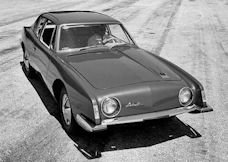Studebaker Champ
 | |
Manufacturer: | Studebaker Corporation |
Type: | Commercial vehicle |
Body type: | Pickup truck |
Production: | 1960 to 1964 |
The Studebaker Champ was a lightweight pickup model manufactured by the Studebaker Corporation from 1960 to 1964.
History
The Studebaker pickups had not undergone a major overhaul for more than ten years, the company was no longer doing well due to falling sales, so the new model had to be assembled from existing components.The champ was probably the first truck with a factory made fiberglass construction. It was still introduced in the very short model year of 1964 and only a handful of them were made.
Basically, the Chassis chassis and loading structure were the same for Studebaker's 1/2-t and 3/4-t trucks since 1949, but the cab clearly differed from its predecessor. The company's annual cash flow problems made it impossible to afford a brand new cab, so the engineers polished a car- based Lark- based design by cutting it off at the B-pillar and attaching it to the truck. Chassis adapted. The front of the Lark was also taken over, but they invested money in a new grille with horizontal bars that looked "tougher".
Studebaker equipped the champ with engines that had been in the program for a long time. In 1960, buyers could choose between the last side-steering six-cylinders: the smaller 2786 cc and 90 bhp (66 kW) and the larger "Big Six" 4015 cc and 110 bhp (81 kW). In 1961, the smaller machine was upgraded with overhead valves, giving it 22 bhp and now delivering 112 bhp (82.4 kW). Thus, Studebaker could take the old Big Six from the program.
The Champ was never offered with power steering in American pickups of the 1960s, despite the fact that this equipment was fitted to the heavier Studebaker Transtar and diesel models. The last 8E models from 1963/1964 had an improved steering system with reduced friction and thus lower steering forces, but not to the degree that power steering would have had. However, in the early 1960s, the power steering was not common in light trucks, and so it was no competitive disadvantage for Studebaker not to offer this special equipment
The new OHV slewing cylinder was indeed redesigned, but contained as much as possible components of the old, 1939 imported engine. The machine earned a bad reputation, as some copies of the cylinder head ripped. The problem that most often occurred with motors whose valves were not properly adjusted has never been completely solved. But with proper care, these engines have been able to last well over 40 years.
From the beginning there were two V8 engines, 4244 cc and 4736 cc, equipped with either double or quad carburettor. Both machines were not significantly changed during the production of the Champ.
For the Champ, there was also a large selection of gears, manual or automatic. The basic models had a steering wheel-connected three-gear transmission ("three on tree"). You could either choose an overdrive or have a four- or five-speed gearbox installed. In addition, the "Flight-O-Matic" from BorgWarner was available as an automatic transmission.
Despite the "cobbled together" construction, the truck sold in 1960 as a 5E series.In 1961 (6E series), a closed body over the entire vehicle width - the "Spaceside" - was additionally offered; the tools were purchased from Dodge . However, this did not boost the sales figures, nor did the new OHV version of the 2.8-liter engine, which became known for the cracks in the cylinder head.
In 1962 (7E series) and 1963 (8E series) Champ was continued without major changes, and the few copies, which were created in 1964, belonged to the 8E series of the previous year. In December 1963, management announced the closure of the South Bend , Indiana factory and the trucks were no longer manufactured at the Hamilton , Ontario, Passenger Cars plant .
It is little noticed that the Champ was the first to have a detail that almost every modern pickup today offers: The opening rear window, which already existed from the start of production in the Champ and was very popular with the buyers. It was later copied by the larger truck manufacturers.Although the Champ could not save Studebaker's truck production, this showed the way to a reasonably sized pickup truck, a feat Dodge attributed to the Dakota , a medium-sized truck. This model was introduced in 1987, 27 years after the Champ.
Rating
Manuals
- Studebaker Previous 5 / 25 Next




